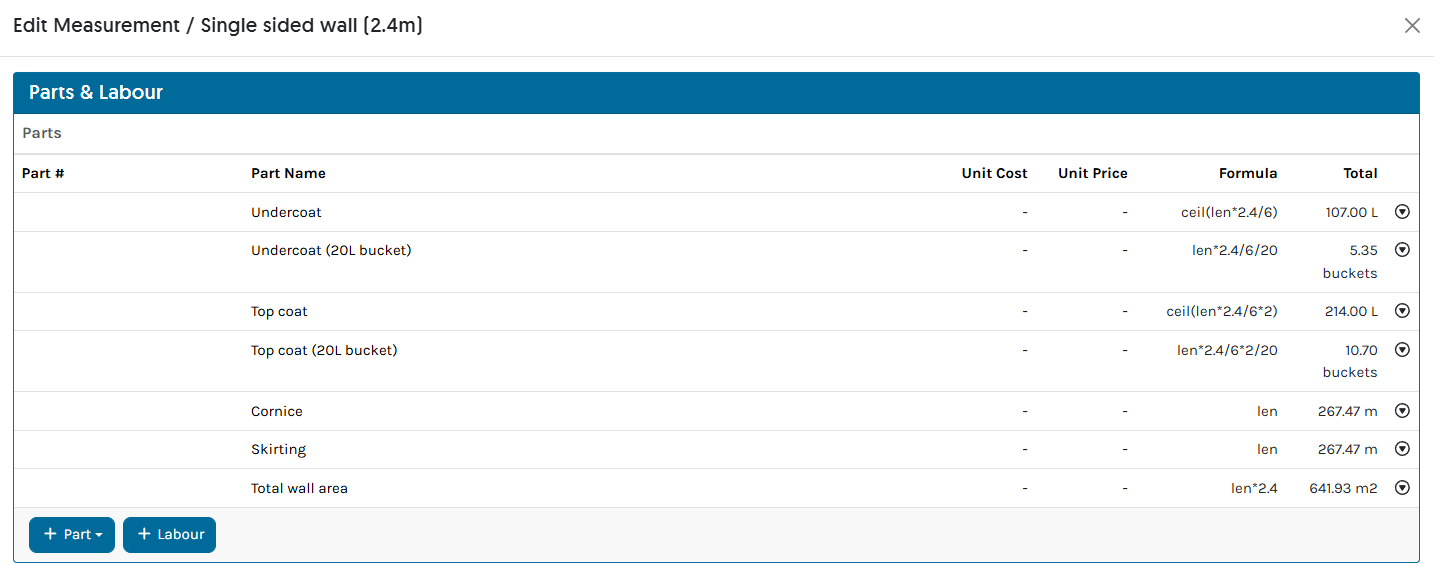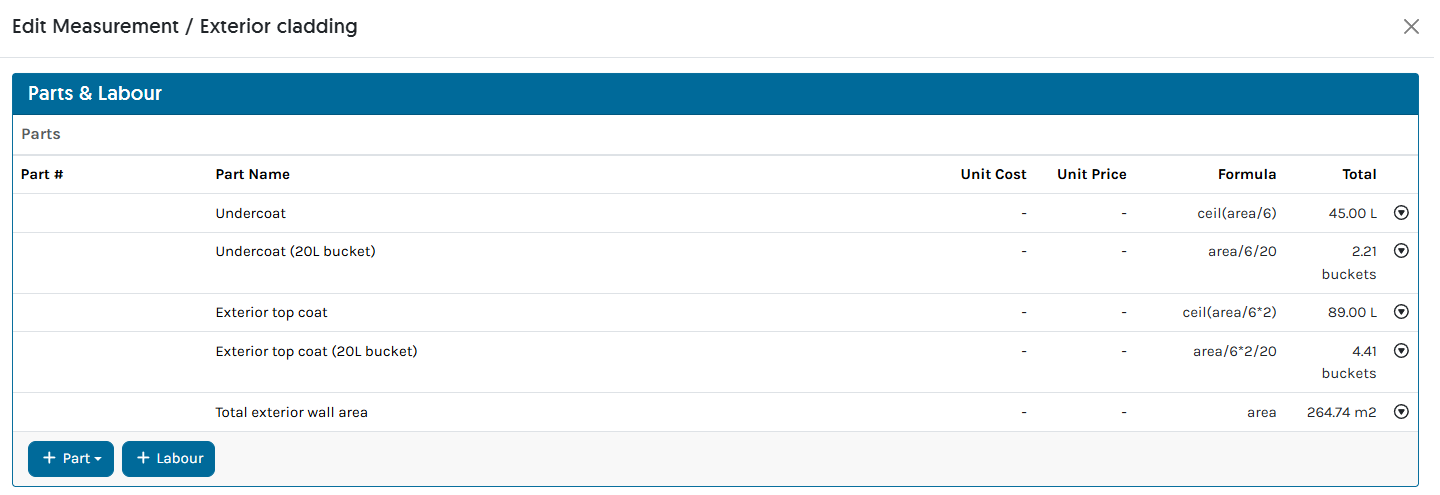Before reading this article, ensure you have read Measurement - Parts & Labour and Using Formula within Groundplan articles to aid in understanding the following Formula examples.
- Doubled-sided and single-sided walls would need separate Measurements as the Parts and Labour are different.
- If there is more than one ceiling height on the Project, each height must be a separate Measurement with the correct Formula, Parts and/or Labour applied.
📝 The Formula values provided in this article are for example purposes only.
| Term | Explained |
|---|---|
count |
total counts |
len |
total metres measured |
area |
total square metres measured |
count, len or area / x |
total count/length/area divided by an amount |
count, len or area * x |
total count/length/area multiplied by an amount |
ceil(x) |
rounding up a decimal value to the next whole number |
Internal Walls
Example Parts for painting a single-sided wall with a 2.4 high ceiling Length Measurement:

| Part | Explanation | Formula | UMO |
|---|---|---|---|
| Undercoat | How many litres are required when the ceiling is 2.4m high divided by an averaged 1 litre based on covering 6m2 |
ceil(len*2.4/6) |
Litres |
| Undercoat (20L bucket) | How many 20L buckets are required when the ceiling is 2.4m high divided by an averaged 1 litre based on covering 6m2 divided by a 20L bucket |
len*2.4/6/20 |
Buckets |
| Top coat | How many litres are required when the ceiling is 2.4m high divided by an averaged 1 litre based on covering 6m2 multiplied by 2 coats required |
ceil(len*2.4/6*2) |
Litres |
| Top coat (20L bucket) | How many 20L buckets are required when the ceiling is 2.4m high divided by an averaged 1 litre based on covering 6m2 multiplied by 2 coats required divided by a 20L bucket |
len*2.4/6/*2/20 |
Buckets |
| Cornice | How many total metres measured |
len |
m |
| Skirting | How many total metres measured |
len |
m |
| Total wall area | Total length measured multiplied by the height of 2.4m for the total m2 |
len*2.4 |
m2 |
Exterior Cladding
Example Parts for painting exterior cladding using an Area Measurement:

| Part | Explanation | Formula | UMO |
|---|---|---|---|
| Undercoat | How many litres are required for the area measured divided by an averaged 1 litre based on covering 6m2 |
ceil(area/6) |
Litres |
| Undercoat (20L bucket) | How many 20L buckets are required for the area measured divided by an averaged 1 litre based on covering 6m2 divided by a 20L bucket |
area/6/20 |
Buckets |
| Top coat | How many litres are required for the area measured divided by an averaged 1 litre based on covering 6m2 multiplied by 2 coats required |
ceil(area/6*2) |
Litres |
| Top coat (20L bucket) | How many 20L buckets are required for the area measured divided by an averaged 1 litre based on covering 6m2 multiplied by 2 coats required divided by a 20L bucket |
area/6/*2/20 |
Buckets |
| Total exterior wall | Total exterior area measured after door / windows were removed |
area |
m2 |
Removals
There are different ways to calculate window and door removals using Parts with negative formula applied. All involve Grouping of Parts. Alternatively, if usage permits, use the Area Cut-Out Tool to remove windows from elevations Plans as well.
Sliding Door Removal
Example Parts for the removal of a 2400mm x 2200mm sliding door using a Count Measurement:

| Part | Explanation | Formula | UMO |
|---|---|---|---|
| Total wall area | Calculating negative m2 of the total area covered by a sliding door 2400mm x 2200mm = 5.28m2 to be removed from the Total wall area Grouped Part |
-count*5.28 |
m2 |
Window Removal
Example Parts for the removal of any length window with a height of 1.2m using a Length Measurement:

| Part | Explanation | Formula | UMO |
|---|---|---|---|
| Total wall area | Calculating a negative m2 of the total area covered by a window with a height of 1.2m to be removed from the Total wall area Grouped Part |
-len*1.2 |
m2 |
For Formula assistance, please reach out to Support. Go to: Help > Send us a Message.
Download a PDF copy of Using Formulas within Groundplan here.
Organise your session today! Click Help > Send us a Message and ask to book in for free training.
Trainers can assist with:
- Workflow solutions
- Time-saving tips
- Making sure you're getting the most out of your subscription
If you've accessed your free training and need further Support, reach out to book a 1 or 2 hour paid session.